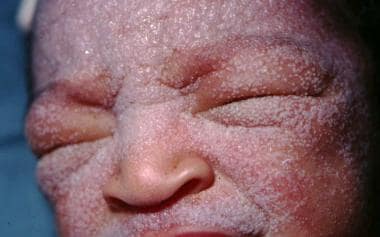Disorders of the sweat glands. Griffiths C, Barker J, Bleiker T, Hussain W, Simpson R, eds. Rook's Textbook of Dermatology. 10th ed. Hoboken, NJ: Wiley-Blackwell; 2024. Chap 92.
Ale I, Lachapelle JM, Maibach HI. Skin tolerability associated with transdermal drug delivery systems: an overview. Adv Ther. 2009 Oct. 26 (10):920-35. [QxMD MEDLINE Link].
Cui CY, Ishii R, Campbell DP, Michel M, Piao Y, Kume T, et al. Foxc1 Ablated Mice Are Anhidrotic and Recapitulate Features of Human Miliaria Sweat Retention Disorder. J Invest Dermatol. 2017 Jan. 137 (1):38-45. [QxMD MEDLINE Link].
Kravvas G, Veitch D, Al-Niaimi F. The increasing relevance of biofilms in common dermatological conditions. J Dermatolog Treat. 2018 Mar. 29 (2):202-207. [QxMD MEDLINE Link].
Mowad CM, McGinley KJ, Foglia A, Leyden JJ. The role of extracellular polysaccharide substance produced by Staphylococcus epidermidis in miliaria. J Am Acad Dermatol. 1995 Nov. 33 (5 Pt 1):729-33. [QxMD MEDLINE Link].
Carter R 3rd, Garcia AM, Souhan BE. Patients presenting with miliaria while wearing flame resistant clothing in high ambient temperatures: a case series. J Med Case Rep. 2011 Sep 22. 5:474. [QxMD MEDLINE Link].
Argoubi H, Fitchner C, Richard O, Lavocat MP, Cambazard F, Stéphan JL. [Pustular miliaria rubra and systemic type 1b pseudohypoaldosteronism in a newborn]. Ann Dermatol Venereol. 2007 Mar. 134 (3 Pt 1):253-6. [QxMD MEDLINE Link].
Urbatsch A, Paller AS. Pustular miliaria rubra: a specific cutaneous finding of type I pseudohypoaldosteronism. Pediatr Dermatol. 2002 Jul-Aug. 19 (4):317-9. [QxMD MEDLINE Link].
Akcakus M, Koklu E, Poyrazoglu H, Kurtoglu S. Newborn with pseudohypoaldosteronism and miliaria rubra. Int J Dermatol. 2006 Dec. 45 (12):1432-4. [QxMD MEDLINE Link].
Tabanelli M, Passarini B, Liguori R, Balestri R, Gaspari V, Giacomini F, et al. Erythematous papules on the parasternal region in a 76-year-old man. Clin Exp Dermatol. 2008 May. 33 (3):369-70. [QxMD MEDLINE Link].
Haas N, Martens F, Henz BM. Miliaria crystallina in an intensive care setting. Clin Exp Dermatol. 2004 Jan. 29 (1):32-4. [QxMD MEDLINE Link].
Gupta AK, Ellis CN, Madison KC, Voorhees JJ. Miliaria crystallina occurring in a patient treated with isotretinoin. Cutis. 1986 Oct. 38 (4):275-6. [QxMD MEDLINE Link].
Seghers AC, Tey HL, Tee SI, Cao T, Chong WS. Pegylated liposomal doxorubicin-induced miliaria crystallina and lichenoid follicular eruption. Indian J Dermatol Venereol Leprol. 2018 Jan-Feb. 84 (1):121. [QxMD MEDLINE Link]. [Full Text].
Godkar D, Razaq M, Fernandez G. Rare skin disorder complicating doxorubicin therapy: miliaria crystallina. Am J Ther. 2005 May-Jun. 12 (3):275-6. [QxMD MEDLINE Link].
Kumar S, Mahajan BB, Kaur S, Singh A. Erythropoietin induced miliaria crystallina: A possible new adverse effect of erythropoietin. Int J Case Rep Images. 2014. 5 (9):634-7. [Full Text].
Valenzuela-Ubiña S, Villegas-Romero I, Jiménez-Gallo D, Arjona-Aguilera C, Linares-Barrios M. Miliaria crystallina induced by idarubicin and all-trans-retinoic acid: Two case reports. Australas J Dermatol. 2021 Aug. 62 (3):e408-e410. [QxMD MEDLINE Link].
Shuster S. Duct disruption, a new explanation of miliaria. Acta Derm Venereol. 1997 Jan. 77 (1):1-3. [QxMD MEDLINE Link].
Hidano A, Purwoko R, Jitsukawa K. Statistical survey of skin changes in Japanese neonates. Pediatr Dermatol. 1986 Feb. 3 (2):140-4. [QxMD MEDLINE Link].
Moosavi Z, Hosseini T. One-year survey of cutaneous lesions in 1000 consecutive Iranian newborns. Pediatr Dermatol. 2006 Jan-Feb. 23 (1):61-3. [QxMD MEDLINE Link].
Huda M, Saha P. Pattern of dermatosis among pediatric patients attending a medical college hospital in northeastern region of India. Indian J Dermatol. 2009. 49:189.
Gopinath H, Karthiga R, Karthikeyan K. A cross-sectional study of sweat-induced dermatitis during a South Indian summer: a glimpse of sweat gland-mediated cutaneous inflammation. Int J Dermatol. 2019 Jan. 58 (1):86-90. [QxMD MEDLINE Link].
Dixit S, Jain A, Datar S, Khurana VK. Congenital miliaria crystallina - A diagnostic dilemma. Med J Armed Forces India. 2012 Oct. 68 (4):386-8. [QxMD MEDLINE Link]. [Full Text].
Haas N, Henz BM, Weigel H. Congenital miliaria crystallina. J Am Acad Dermatol. 2002 Nov. 47 (5 Suppl):S270-2. [QxMD MEDLINE Link].
Palaniappan V, Sadhasivamohan A, Sankarapandian J, Karthikeyan K. Miliaria crystallina. Clin Exp Dermatol. 2023 Apr 27. 48 (5):462-467. [QxMD MEDLINE Link].
Kirk JF, Wilson BB, Chun W, Cooper PH. Miliaria profunda. J Am Acad Dermatol. 1996 Nov. 35 (5 Pt 2):854-6. [QxMD MEDLINE Link].
Haque MS, Hailu T, Pritchett E, Cusack CA, Allen HB. The oldest new finding in atopic dermatitis: subclinical miliaria as an origin. JAMA Dermatol. 2013 Apr. 149 (4):436-8. [QxMD MEDLINE Link].
Al-Hilo, Maytham M, Al-Saedy SJ, Alwan AI. Atypical Presentation of Miliaria in Iraqi Patients Attending Al-Kindy Teaching Hospital in Baghdad: A Clinical Descriptive Study. Am J Dermatol Venereol. 2012. 41-6.
Doshi BR, Mahajan S, Kharkar V, Khopkar US. Granulomatous variant of giant centrifugal miliaria profunda. Pediatr Dermatol. 2013 Jul-Aug. 30 (4):e48-51. [QxMD MEDLINE Link].
Chadha AA, Mahajan SA, Dongre A, Khopkar US. Granulomatous Variant of Giant Centrifugal Miliaria Profunda in a Hypothyroid Infant: A Case Report. Indian Dermatol Online J. 2019 Sep-Oct. 10 (5):564-566. [QxMD MEDLINE Link]. [Full Text].
Mohanan S, Behera B, Chandrashekar L, Kar R, Thappa DM. Bull's-eye pattern in miliaria rubra. Australas J Dermatol. 2014 Nov. 55 (4):263-5. [QxMD MEDLINE Link].
Verzì AE, Micali G, Lacarrubba F. Line-field confocal optical coherence tomography of miliaria crystallina: An in vivo, three-dimensional imaging. JAAD Case Rep. 2024 Jun. 48:83-84. [QxMD MEDLINE Link]. [Full Text].
Tey HL, Tay EY, Cao T. In vivo imaging of miliaria profunda using high-definition optical coherence tomography: diagnosis, pathogenesis, and treatment. JAMA Dermatol. 2015 Mar. 151 (3):346-8. [QxMD MEDLINE Link].



